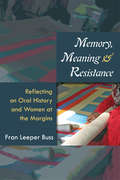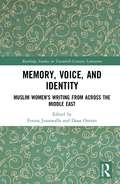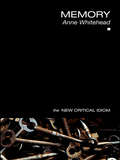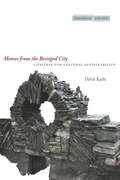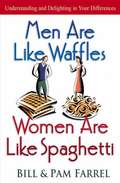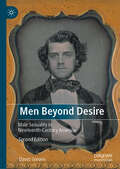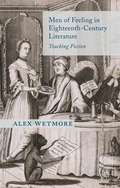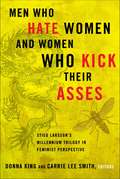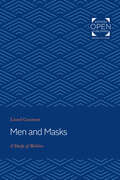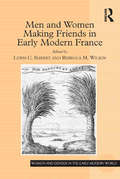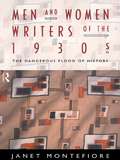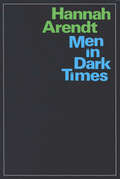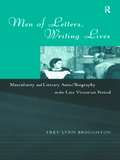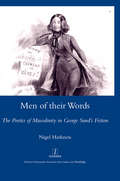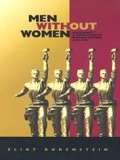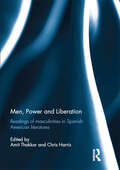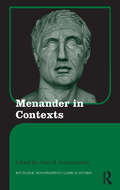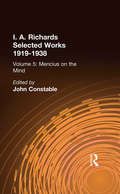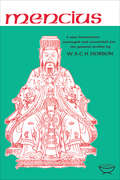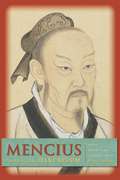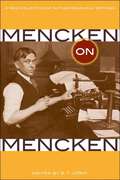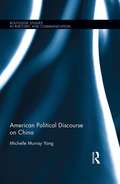- Table View
- List View
Memory, Meaning, and Resistance: Reflecting on Oral History and Women at the Margins
by Fran Leeper BussFran Leeper Buss, a former welfare recipient who earned a PhD in history and became a pioneer in the field of oral history, has for forty years dedicated herself to the goal of collecting the stories of marginal and working-class U.S. women. Memory, Meaning, and Resistance is based on over 100 oral histories gathered from women from a variety of racial, ethnic, and geographical backgrounds, including a traditional Mexican American midwife, a Latina poet and organizer for the United Farm Workers, and an African American union and freedom movement organizer. Buss now analyzes this body of work, identifying common themes in women’s lives and resistance that unite the oral histories she has gathered. From the beginning, her work has shed light on the inseparable, compounding effects of gender, race, ethnicity, and class on women’s lives—what is now commonly called intersectionality. Memory, Meaning, and Resistance is structured thematically, with each chapter analyzing a concept that runs through the oral histories, e.g., agency, activism, religion. The result is a testament to women’s individual and collective strength, and an invaluable guide for students and researchers, on how to effectively and sensitively conduct oral histories that observe, record, recount, and analyze women’s life stories.
Memory, Voice, and Identity: Muslim Women’s Writing from across the Middle East (Routledge Studies in Twentieth-Century Literature)
by Feroza Jussawalla Doaa OmranMuslim women have been stereotyped by Western academia as oppressed and voiceless. This volume problematizes this Western academic representation. Muslim Women Writers from the Middle East from Out al-Kouloub al-Dimerdashiyyah (1899–1968) and Latifa al-Zayat (1923–1996) from Egypt, to current diasporic writers such as Tamara Chalabi from Iraq, Mohja Kahf from Syria, and even trendy writers such as Alexandra Chreiteh, challenge the received notion of Middle Eastern women as subjugated and secluded. The younger largely Muslim women scholars collected in this book present cutting edge theoretical perspectives on these Muslim women writers. This book includes essays from the conflict-ridden countries such as Iran, Iraq, Palestine, Syria, and the resultant diaspora. The strengths of Muslim women writers are captured by the scholars included herein. The approach is feminist, post-colonial, and disruptive of Western stereotypical academic tropes.
Memory: A Reader (The New Critical Idiom)
by Anne WhiteheadThe concept of ‘memory’ has given rise to some of the most exciting new directions in contemporary theory. In this much-needed guide to a burgeoning field of a study, Anne Whitehead: presents a history of the concept of ‘memory’ and its uses, encompassing both memory as activity and the nature of memory examines debates around the term in their historical and cultural contexts introduces the reader to key thinkers in the field, from ancient Greece to the present day traces the links between theorisations and literary representations of memory. Offering a clear and succinct guide to one of the most important terms in contemporary theory, this volume is essential reading for anyone entering the field of Memory Studies, or seeking to understand current developments in Cultural and Literary Studies.
Memos from the Besieged City: Lifelines for Cultural Sustainability
by Djelal KadirKadir (comparative literature, Pennsylvania State U.) conducts a genealogy of the major facets of the discipline of comparative literature by thematically addressing key concerns of the field in relation to the ideas of key world cultural figures from the 13th century to the present. The thematic chapters discuss the concept of the subject; world history and world literature; cultural space and identity; memory, culture, and memory management; orthodoxy, consensus, and conspiracy; poetics and ekphrasis (dramatic description); ethics; literature, the nation, and the state; and metadiscourse and spectralization. The themes are considered in relation to the following persons: Rashiduddin Fazlullah (1247-1318), Nicholas of Cusa (1401-64), Giordano Bruno (1548-1600), Fray Servando Teresa de Mier (1763-1827), Erich Auerbach (1892-1957), Hannah Arendt (1906-75), Zbigniew Herbert (1924-98), Italo Calvino (1923-85), Gao Xingjian (b. 1940), and Orhan Pamuk (b. 1952). Annotation ©2011 Book News, Inc., Portland, OR (booknews.com)
Men Are Like Waffles, Women Are Like Spaghetti
by Bill Farrel Pam FarrelThe authors, a husband and wife team, invite couples to join them on a journey of laughter and discovery of the unique gifts God has given to each gender. Find practical ideas for honoring each other and help to solve the long-standing fights that many marriages experience. Find out why men are like waffles and why they still go well with the women who are like spaghetti.
Men Beyond Desire: Male Sexuality in Nineteenth-Century America
by David GrevenThis book explores the construction of male sexuality in nineteenth-century American literature and overturns longstanding views. Far from desiring heterosexual sex and wishing to bond with other men through fraternity, the male protagonists of classic American literature mainly want to be left alone. Greven makes the claim that American men, eschewing both marriage and male friendship, strive to remain emotionally and sexually inviolate. Examining the work of traditional authors - Hawthorne, Poe, Melville, Cooper, Irving, Stowe - Greven discovers consistently resistant portrayals of male characters who defend their individuality through a lockdown on sexuality. Objects of desire from both women and other men, the inviolate males discussed in this study disrupt established gendered and sexual categories, inspiring fresh analysis of the era and its literary depiction of American manhood. This second edition of Men Beyond Desire (2005) expands the analysis of male sexuality to include discussions of developments in the field of masculinity studies. It includes a new introduction that introduces the complementary figure of the “victim-monster” and revisits the work of Leslie Fiedler, and a new chapter that focuses on Melville's tale "Bartleby the Scrivener" (1856). Chapter 4 expands the analysis of the intersections among free love, health reform, and male sexuality in The Blithedale Romance (1852), and chapter 9 expands the discussion of Billy Budd, Sailor to address questions of race and the role of the Handsome Sailor.
Men Of Feeling In Eighteenth-century Literature
by Alex WetmoreAnalysing texts by Sterne, Smollett, Brooke, and Mackenzie, this book offers a new perspective on a question that literary criticism has struggled with for years: why are many sentimental novels of the 1700s so pervasively and playfully self-conscious, and why is this self-consciousness so often directed toward the materiality of the printed word?
Men Who Hate Women and Women Who Kick Their Asses: Stieg Larsson's Millennium Trilogy in Feminist Perspective
by Donna King Carrie Lee SmithStieg Larsson was an unabashed feminist in his personal and professional life and in the fictional world he created, but The Girl with the Dragon Tattoo, The Girl Who Played with Fire, and The Girl Who Kicked the Hornet's Nest are full of graphic depictions of violence against women, including stalking, sexual harassment, child abuse, rape, incest, serial murder, sexual slavery, and sex trafficking, committed by vile individual men and by corrupt, secretive institutions. How do readers and moviegoers react to these depictions, and what do they make of the women who fight back, the complex masculinities in the trilogy, and the ambiguous gender of the elusive Lisbeth Salander? These lively and accessible essays expand the conversation in the blogosphere about the novels and films by connecting the controversies about gender roles to social trends in the real world.
Men Who Hate Women and Women Who Kick Their Asses: Stieg Larsson's Millennium Trilogy in Feminist Perspective
by Donna King and Carrie Lee SmithStieg Larsson was an unabashed feminist in his personal and professional life and in the fictional world he created, but The Girl with the Dragon Tattoo, The Girl Who Played with Fire, and The Girl Who Kicked the Hornet's Nest are full of graphic depictions of violence against women, including stalking, sexual harassment, child abuse, rape, incest, serial murder, sexual slavery, and sex trafficking, committed by vile individual men and by corrupt, secretive institutions. How do readers and moviegoers react to these depictions, and what do they make of the women who fight back, the complex masculinities in the trilogy, and the ambiguous gender of the elusive Lisbeth Salander? These lively and accessible essays expand the conversation in the blogosphere about the novels and films by connecting the controversies about gender roles to social trends in the real world.
Men and Masks: A Study of Molière
by Lionel GossmanOriginally published in 1963. Molière's plays rank among the great comic achievements in the history of the stage. Yet few attempts have been made to understand them as expressing the historical context of the author's time. Most frequently they have been interpreted from the point of view of purely literary history, while the characters have been seen as universal comic types. Lionel Gossman reappraises Molière's comedy in the light of historical experience and interprets it in terms of the conditions from which it emerged. He brings it into the mainstream of seventeenth-century French literature and shows that Molière was concerned with the same things that concerned Descartes, Corneille, Racine, or Pascal. Five comedies (Amphitryon, Dom Juan, Le Misanthrope, Le Tartuffe, and George Dandin) are studied in the first part of the book. A number of basic structures are found to be common to all of them, and these give the author his point of departure for the second part of the book. In the second part, Gossman examines Molière's position with respect to other major seventeenth-century French writers. The comic vision of Molière, Gossman argues, no less than the tragic vision of Pascal or of Racine, expresses a particular relation to the social structure of the time. The subject matter of Molière's comedy is thus, in the author's view, not universal human nature but the men and women of the society in which Molière lived. Indeed, Gossman goes on to argue that the development of society after Molière made it difficult, and in the end impossible, for later writers to see the world in the comic light that illuminated Molière's writing. Even in certain of Molière's own works, in fact, the comic vision shades into something close to Romantic irony.
Men and Women Making Friends in Early Modern France (Women and Gender in the Early Modern World)
by Lewis C. Seifert Rebecca M. WilkinToday the friendships that grab people’s imaginations are those that reach across inequalities of class and race. The friendships that seem to have exerted an analogous level of fascination in early modern France were those that defied the assumption, inherited from Aristotle and patristic sources, that friendships between men and women were impossible. Together, the essays in Men and Women Making Friends in Early Modern France tell the story of the declining intelligibility of classical models of (male) friendship and of the rising prominence of women as potential friends. The revival of Plato’s friendship texts in the sixteenth century challenged Aristotle’s rigid ideal of perfect friendship between men. In the seventeenth century, a new imperative of heterosociality opened a space for the cultivation of cross-gender friendships, while the spiritual friendships of the Catholic Reformation modeled relationships that transcended the gendered dynamics of galanterie. Men and Women Making Friends in Early Modern France argues that the imaginative experimentation in friendships between men and women was a distinctive feature of early modern French culture. The ten essays in this volume address friend-making as a process that is creative of self and responsive to changing social and political circumstances. Contributors reveal how men and women fashioned gendered selves, and also circumvented gender norms through concrete friendship practices. By showing that the benefits and the risks of friendship are magnified when gender roles and relations are unsettled, the essays in this volume highlight the relevance of early modern friend-making to friendship in the contemporary world.
Men and Women Writers of the 1930s: The Dangerous Flood of History
by Janet MontefioreMen and Women Writers of the 1930s is a searching critique of the issues of memory and gender during this dynamic decade. Montefiore asks two principle questions; what part does memory play in the political literature of and about 1930s Britain? And what were the roles of women, both as writers and as signifying objects in constructing that literature? Montefiore's topical analysis of 1930s mass unemployment, fascist uprise and 'appeasement' is shockingly relevant in society today. Issues of class, anti-fascist historical novels, post war memoirs of 'Auden generation' writers and neglected women poets are discussed at length. Writers include: * George Orwell * Virginia Woolf * W.H. Auden * Storm Jameson * Jean Rhys * Rebecca West
Men in Dark Times
by Hannah Arendt“Each [essay is] a model of clarity, weight, gravity . . . each superbly centered on the moods, manners, works . . . of ten exemplary men and women” (Kirkus Reviews, starred review).“Dark times” is Brecht's phrase, and Hannah Arendt uses it suggest that those she writes about are not “mouthpieces of the Zeitgeist”, but, rather, that the routine repetitive horrors of the twentieth century form the substance of the dark against which their lives of illumination were lived. Containing essays from Dr. Arendt on Karl Jaspers, Rosa Luxemburg, Pope John XXIII, Isak Dinesen, Bertolt Brecht, Randall Jarrell, and others whose lives and work shed light on the early part of the century.
Men of Letters, Writing Lives: Masculinity And Literary Auto/biography In The Late-victorian Period
by Trev Lynn BroughtonTrev Lynn Broughton takes an in-depth look at the developments within Victorian auto/biography, and asks what we can learn about the conditions and limits of male literary authority. Providing a feminist analysis of the effects of this literary production on culture, Broughton looks at the increase in professions with a vested interest in the written Life; the speeding up of the Life-and-Letters industry during this period; the institutionalization of Life-writing; and the consequent spread of a network of mainly male practitioners and commentators. This study focuses on two case studies from the period 1880-1903: the theories and achievements of Sir Leslie Stephen and the debate surrounding James Anthony Froude's account of the marriage of Thomas and Jane Welsh Carlyle.
Men of Their Words: The Poetics of Masculinity in George Sand's Fiction
by Nigel Harkness"Whereas the centrality of femininity to nineteenth-century French fiction has been the focus of widespread critical attention, masculinity has, until recently, received little sustained treatment in either the literary or socio-historical domains. In this book, Nigel Harkness uses the fiction of George Sand (1804-1876), the pre-eminent woman writer of the period, to explore questions of masculinity as they pertain to the nineteenth-century French novel, and to map out new approaches to the study of literary masculinity. Drawing on contemporary theories of gender and narrative, Harkness reveals how Sands novels repeatedly focus on a nexus of language, masculinity and power, in which narrative is both a vehicle for the expression of manhood, and a site where masculinity is discursively performed. Masculinity is thus reconfigured in Sands fiction as an identity constituted as much through words as through actions. Analysis of the performances of masculinity staged in Sands novels opens onto an exploration of gendered processes of literary representation: the links between masculinity and the doxa, the equation of writing and power, the homosocial function of acts of narration, and the masculinity of authorship and authority."
Men without Women: Masculinity and Revolution in Russian Fiction, 1917–1929
by Eliot BorensteinIn Men without Women Eliot Borenstein examines the literature of the early Soviet period to shed new light on the iconic Russian concept of comradeship. By analyzing a variety of Russian writers who span the ideological spectrum, Borenstein provides an illuminating reading of the construction of masculinity in Soviet culture. In each example he identifies the replacement of blood ties with ideology and the creation of a social order in which the family has been supplanted by the collective. In such works as Red Cavalry by Isaac Babel, Envy by Yuri Olesha, and Chevengur by Andrei Platonov women are either absent or transformed into bodiless abstractions. Their absence, claims Borenstein, reflects the masculine values that are hallmarks of the post-revolutionary era: production rather than reproduction, participation in history rather than domestic ahistoricity, heavy industry, construction, and struggle. He identifies in this literature groups of "men without women" replacing the family, even while the metaphor of family is used as an organizing feature of their recurring revolutionary missions. With the passage of time, these characters' relationships--just as those in the Soviet culture of the time--begin to resemble the family structure that was originally rejected and destroyed, with one important exception: the new "families" had no place for women. According to Borenstein, this masculinist myth found its most congenial audience during the early period of communism, but its hostility to women and family ties could not survive into the Stalinist era when women, home, and family were no longer seen as antithetical to socialism. Drawing on the theory and writings of Levi-Strauss, Girard, Sedgwick, and others, Men Without Women will be of interest to students and scholars of Slavic literature and history as well as specialists in literary theory and gender studies.
Men, Power and Liberation: Readings of Masculinities in Spanish American Literatures
by Amit Thakkar and Chris HarrisEach contribution to this book discusses key issues arising from the portrayal of men and the formation of masculine identities in a range of representative and landmark texts, fictional and non-fictional, drawn from different historical periods and from various countries in the Hispanophone Americas. There is an emphasis on the ways in which writers from Argentina (Manuel Puig), Chile (the Spaniard Alonso de Ercilla y Zúñiga and the Chilean Nicolás Palacios), Mexico (Gustavo Sainz and Ángeles Mastretta) and the Hispanic USA (Jennifer Harbury and Francisco Goldman) have explored the themes of love, friendship and trust and their transformative power for gender relations in situations and contexts where deception, exploitation and oppression are often disturbingly present. There is also a discussion of the applications, insights and limitations of different theoretical frameworks and concepts relevant to the task of producing gendered readings, including Connell’s ‘world gender order’ and ‘hegemonic masculinity’, as well as ‘the cult of virility’ as characterised by Still and Worton, Chela Sandoval’s ‘decolonial love’ and ‘methodology of the oppressed’ and Beasley-Murray’s ‘posthegemony’. This book was originally published as a special issue of Iberian and Latin American Studies.
Menander in Antiquity
by Sebastiana NervegnaThe comic playwright Menander was one of the most popular writers throughout antiquity. This book reconstructs his life and the legacy of his work until the end of antiquity employing a broad range of sources such as portraits, illustrations of his plays, papyri preserving their texts and inscriptions recording their public performances. These are placed within the context of the three social and cultural institutions which appropriated his comedy, thereby ensuring its survival: public theatres, dinner parties and schools. Dr Nervegna carefully reconstructs how each context approached Menander's drama and how it contributed to its popularity over the centuries. The resultant, highly illustrated, book will be essential for all scholars and students not just of Menander's comedy but, more broadly, of the history and iconography of the ancient theatre, ancient social history and reception studies.
Menander in Contexts: Menander In Contexts (Routledge Monographs in Classical Studies #16)
by Alan H. SommersteinThe comedies of the Athenian dramatist Menander (c. 342-291 BC) and his contemporaries were the ultimate source of a Western tradition of light drama that has continued to the present day. Yet for over a millennium, Menander’s own plays were thought to have been completely lost. Thanks to a long and continuing series of papyrus discoveries, Menander has now been able to take his place among the major surviving ancient Greek dramatists alongside Aeschylus, Sophocles, Euripides and Aristophanes. In this book, sixteen contributors examine and explore the Menander we know today in light of the various literary, intellectual, and social contexts in which his plays can be viewed. Topics covered include: the society, culture, and politics of his generation; the intellectual currents of the period; the literary precursors who inspired Menander (or whom he expected his audiences to recall); and responses to Menander, from his own time to ours. As the first wide-ranging collective study of Menander in English, this book is essential reading for those interested in ancient comedy the world over.
Menander, New Comedy and the Visual
by Antonis K. PetridesThis book argues that New Comedy has a far richer performance texture than has previously been recognised. Offering close readings of all the major plays of Menander, it shows how intertextuality - the sustained dialogue of New Comedy performance with the diverse ideological, philosophical, literary and theatrical discourses of contemporary polis culture - is crucial in creating semantic depth and thus offsetting the impression that the plots are simplistic love stories with no political or ideological resonances. It also explores how the visual aspect of the plays ('opsis') is just as important as any verbal means of signification - a phenomenon termed 'intervisuality', examining in particular depth the ways in which the mask can infuse various systems of reference into the play. Masks like the panchrēstos neaniskos (the 'all-perfect youth'), for example, are now full of meaning; thus, with their ideologically marked physiognomies, they can be strong instigators of literary and cultural allusion.
Mencius On The Mind: Experiments in Multiple Definition
by John ConstableFirst Published in 2001. Routledge is an imprint of Taylor & Francis, an informa company.
Mencius: A New Translation Arranged and Annotated for the General Reader
by W.A.C.H. DobsonMost educated Westerners are familiar with the thinkers and prophets who inform the Western spirit. But they are less familiar with the thinkers who have shaped the major oriental civilizations. The heirs of these ancient civilizations are now once again in the ascendant. We must understand the ways and thoughts that condition their conduct. The Works of Mencius provides an admirable insight into one of the streams of thought of the Chinese. Indeed, the perceptive reader might well find that some ideas he though were new and alien in the new China have familiar echoes in Mencius. This new translation, especially arranged and annotated with the general reader in mind, has been made in the light of recent philological research. It aims at rendering an Archaic Chinese original in a modern and unadorned prose, and is intended for the general reader who is otherwise unfamiliar with Chinese authors and desires to understand what Mencius is about without encumbering the text with footnotes and technical apparatus which the specialist quite properly demands. While the text has been translated in its entirety its parts have been rearranged in a sequence which it is hoped will make them easier for the Western reader.
Mencius: The Great Learning, The Doctrine Of The Mear [i. E. Mean] Confucian Analects [and] The Works Of Mencius (Translations from the Asian Classics)
by MenciusKnown throughout East Asia as Mengzi, or "Master Meng," Mencius (391-308 B.C.E.) was a Chinese philosopher of the late Zhou dynasty, an instrumental figure in the spread of the Confucian tradition, and a brilliant illuminator of its ideas. Mencius was active during the Warring States Period (403-221 B.C.E.), in which competing powers sought to control the declining Zhou empire. Like Confucius, Mencius journeyed to one feudal court after another, searching for a proper lord who could put his teachings into practice. Only a leader who possessed the moral qualities of a true king could unify China, Mencius believed, and in his defense of Zhou rule and Confucian philosophy, he developed an innovative and highly nuanced approach to understanding politics, self-cultivation, and human nature, profoundly influencing the course of Confucian thought and East Asian culture.Mencius is a record of the philosopher's conversations with warring lords, disciples, and adversaries of the Way, as well as a collection of pronouncements on government, human nature, and a variety of other philosophical and political subjects. Mencius is largely concerned with the motivations of human actors and their capacity for mutual respect. He builds on the Confucian idea of ren, or humaneness, and places it alongside the complementary principle of yi, or rightness, advancing a complex notion of what is right for certain individuals as they perform distinct roles in specific situations. Consequently, Mencius's impact was felt not only in the thought of the intellectual and social elite but also in the value and belief systems of all Chinese people.
Mencken on Mencken: A New Collection of Autobiographical Writings
by H. L. Mencken S. T. Joshi"Mencken weighs 172 pounds, is 5 feet 10 inches in height and not beautiful. His chief amusement, after reading, is piano-playing, this he does very crudely. He takes no exercise except walking and is a moderate eater and drinker. He sometimes drinks as little as one bottle of beer a week, though this doesn't happen very often." So wrote H. L. Mencken about himself, in a brief sketch of his life penned in 1905.Perhaps America's foremost literary stylist and most mordant wit, Mencken's most engaging writing told about his own life and experiences. In Mencken on Mencken, veteran Mencken editor and scholar S. T. Joshi has assembled a hefty collection of the best of Mencken's autobiographical pieces that have not appeared previously in book form. These forty-four selections cover a wide variety of topics ranging from incidents from Mencken's everyday life to reflections on friends and colleagues to his careers as author, journalist, and editor, to his travels abroad. As a journalist in Baltimore, Mencken encountered many unusual characters: a professional mourner hired by a beer distiller, a wagon driver who slept through the great Baltimore fire of 1904, a confirmed bachelor who left town to avoid the clutches of a predatory widow. He provides accounts of literary figures he knew, such as Theodore Dreiser, and ruminations on his work at the Baltimore Sun and as editor for the magazines Smart Set and the American Mercury. In an essay titled "What I Believe," he eschews humor and writes straightforwardly of his longtime scorn for the idea of religion, and in his journalist mode he reflects on a half-century of attending political conventions, drawing on his vast inside knowledge to savage the corruption and incompetence of the political class. A superb travel writer, Mencken gives us a rollicking account of beer-drinking in Munich, astute observations of political unrest in Cuba, and carefully drawn scenes from a long tour he and his wife made of the Mediterranean in 1934.Joshi has thoroughly annotated the pieces and also compiled an extensive glossary of names and terms that Mencken mentions. Mencken on Mencken offers a fully rounded self-portrait of one of America's most colorful personalities and most extraordinary men of letters.
Mendacity and the Figure of the Liar in Seventeenth-Century French Comedy (Routledge Studies in Renaissance Literature and Culture)
by Emilia Wilton-GodberffordeThe first book-length study devoted to this topic, Mendacity and the Figure of the Liar in Seventeenth-Century French Comedy offers an important contribution to scholarship on the theatre as well as on early modern attitudes in France, specifically on the subject of lying and deception. Unusually for a scholarly work on seventeenth-century theatre, it is particularly alert to plays as performed pieces and not simply printed texts. The study also distinguishes itself by offering original readings of Molière alongside innovative analyses of other playwrights. The chapters offer fresh insights on well-known plays by Molière and Pierre Corneille but also invite readers to discover lesser-known works of the time (by writers such as Benserade, Thomas Corneille, Dufresny and Rotrou). Through comparative and sustained close readings, including a linguistic and speech act approach, a historical survey of texts with an analysis of different versions and a study of irony, the reader is shown the manifest ways in which different playwrights incorporate the comedic tropes of lying and scheming, confusion and unmasking. Drawing particular attention to the levels of communicative or mis-communicative exchanges on the character-to-character axis and the character-to-audience axis, this work examines the process whereby characters in the comedies construct narratives designed to trick, misdirect, dazzle, confuse or exploit their interlocutors. In the different incarnations of seducer, parasite, cross-dresser, duplicitous narrator/messenger and deluded mythomaniac, the author underscores the way in which the figure of the liar both entertains and troubles, making it a fascinating subject worthy of detailed investigation.
